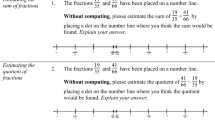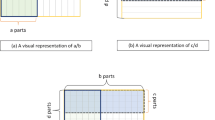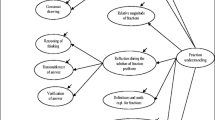Abstract
The mathematical domain of fraction division continues to be an area of great difficulty for many teachers and preservice teachers (Lo and Luo, Journal for Mathematics Teacher Education 15:481–500, 2012; Newton, American Educational Research Journal 45:1080–1110, 2008; Rizvi and Lawson, International Education Journal 8(2):377–392, 2007; Young and Zientek, Investigations in Mathematics Learning 4(1):1-23, 2011). In this study, preservice teachers were given a fraction division task that sought to investigate their own personal approaches to solving a fraction division problem. Their results were contrasted with their ability to interpret student work on the same task. The purpose was to uncover information and gain greater insight into conceptualizations of fraction division they used and links or connections they made among verbal, diagrammatic, and algebraic representations as they solved the task themselves and then analyzed sample student solutions to the same task. Our findings have implications for future research and instruction on fraction division.





Similar content being viewed by others
References
Association of Mathematics Teacher Educators. (2017). Standards for preparing teachers of mathematics. http://amte.net/standards. Accessed 21 Dec 2018.
Adu-Gyamfi, K., & Bossé, M. (2014). Processes and reasoning in representations of linear functions. International Journal of Science and Mathematics Education, 12(1), 167–192.
Adu-Gyamfi, K., Bossé, M. J., & Chandler, K. (2017). Student connections between algebraic and graphical polynomial representations in the context of a polynomial relation. International Journal of Science and Mathematics Education, 15(5), 915–938.
Ball, D. L. (1990). The mathematics understandings that prospective teachers bring to teacher education. Elementary School Journal, 90(4), 449–467.
Ball, D. L., Thames, M. H., & Phelps, G. (2008). Content knowledge for teaching: what makes it special? Journal of Teacher Education, 59(5), 389–407.
Behr, M., Harel, G., Post, T., & Lesh, R. (1992). Rational number, ratio, and proportion. In D. A. Grouws (Ed.), Handbook of research on mathematics teaching and learning (pp. 296–333). New York: Macmillan.
Booth, J. L., & Newton, K. J. (2012). Fractions: could they really be the gatekeeper’s doorman? Contemporary Educational Psychology, 37(4), 247–253.
Bruner, J. (1966). Toward a theory of instruction. Cambridge, MA: Belknap Press.
Bulgar, S. (2009). A longitudinal study of students’ representations for division of fractions. The Montana Mathematics Enthusiast, 6(1), 165–200.
Charalambous, C. Y., & Pitta-Pantazi, D. (2007). Drawing on a theoretical model to study students’ understandings of fractions. Educational Studies in Mathematics, 64(3), 293–316.
Cramer, K., & Wyberg, T. (2009). Efficacy of different concrete models for teaching the part-whole construct for fractions. Mathematical Thinking and Learning, 11(4), 226–257.
Dienes, Z. P. (1960). Building up mathematics. London: Hutchinson Educational.
Dixon, J. K., Andreasen, J. B., Avila, C. L., Bawatney, Z., Deichert, D. L., Howse, T. D., & Turner, M. S. (2014). Redefining the whole: common errors in elementary preservice teachers’ self-authored word problems for fraction subtraction. Investigations in Mathematics Learning, 7(1), 1–22.
Duval, R. (2006). A cognitive analysis of problems of comprehension in the learning of mathematics. Educational Studies in Mathematics, 61, 103–131.
Empson, S. (1995). Using sharing situations to help children learn fractions. Teaching Children Mathematics, 2, 110–114.
Empson, S. B., & Levi, L. (2011). Extending children’s mathematics: fractions and decimals, innovations in cognitively guided instruction. Portsmouth, NH: Heinemann.
Flores, A. (2002). Profound understanding of fraction division. In B. Litwiller (Ed.), Making sense of fractions, ratios, and proportions, 2002 yearbook of the National Council of Teachers of Mathematics (pp. 237–246). Reston, VA: National Council of Teachers of Mathematics.
Goldin, G. A. (1998). Representational systems, learning, and problem solving in mathematics. Journal of Mathematical Behavior, 17(2), 137–165.
Greeno, J. G., & Hall, R. P. (1997). Practicing representation: learning with and about representational forms. Phi Delta Kappan, 78, 361–367.
Gregg, J., & Gregg, D. U. (2007). Measurement and fair-sharing models for dividing fractions. Mathematics Teaching in the Middle School., 12(9), 490–496.
Hackenberg, A. J., & Lee, M. Y. (2016). Students’ distributive reasoning with fractions and unknowns. Educational Studies in Mathematics, 93(2), 245–263.
Hiebert, J. (1988). A theory of developing competence with written mathematical symbols. Educational Studies in Mathematics, 19, 333–355.
Jansen, A., & Hohensee, C. (2016). Examining and elaborating upon the nature of elementary prospective teachers’ conceptions of partitive division with fractions. Journal of Mathematics Teacher Education, 19(6), 503–522.
Kaput, J. J. (1987). Toward a theory of symbol use in mathematics. In C. Janvier (Ed.), Problems of representation in mathematics learning and problem solving (pp. 159–195). Hillsdale, NJ: Erlbaum.
Kieren, T. E. (1980). The rational number constructs—its elements and mechanisms. In T. E. Kieren (Ed.), Recent research in number learning (pp. 125–150). Washington, D.C.: National Institute of Education.
Kieren, T. E. (1992). Rational and fractional numbers as mathematical and personal knowledge: implications for curriculum and instruction. In G. Leinhardt, R. Putnam, & R. A. Hattrup (Eds.), Analysis of arithmetic for mathematics teaching (pp. 323–370). Hillsdale, N.J: Lawrence Erlbaum.
Lamon, S. (2007). Rational numbers and proportional reasoning: towards a theoretical framework for research. In F. K. Lester Jr. (Ed.), Second handbook of research on mathematics teaching and learning (pp. 629–666). Charlotte, NC: Information Age Publishing.
Lee, H. S., & Sztajn, P. (2008). Focusing on units to support prospective elementary teachers’ understanding of division in fractional contexts. School Science and Mathematics, 108, 20–27.
Li, Y., & Kulm, G. (2008). Knowledge and confidence of prospective mathematics teachers: The case of fraction division. ZDM–The International Journal on Mathematics Education, 40, 833–843.
Li, Y., Chen, X., & Kulm, G. (2009). Mathematics teachers’ practices and thinking in lesson plan development: a case of teaching fraction division. ZDM Mathematics Education, 41, 717–731.
Lin, C., Becker, J., Byun, M., Yang, D., & Huang, T. (2013). Preservice teachers’ conceptual and procedural knowledge of fraction operations: a comparative study of the United States and Taiwan. School Science and Mathematics, 113(1), 41–51.
Lo, J., & Luo, F. (2012). Prospective elementary teachers’ knowledge of fraction division. Journal for Mathematics Teacher Education, 15, 481–500. https://doi.org/10.1007/s10857-012-9221-4.
Ma, L. (1999). Knowing and teaching elementary mathematics. Mahwah, NJ: Lawrence Erlbaum Associates.
Miles, M. B., & Huberman, M. N. (1994). Qualitative data analysis: an expanded sourcebook. Thousand Oaks, CA: Sage.
National Mathematics Advisory Panel. (2008). Foundations for success: The final report of the National Mathematics Advisory Panel. Washington, DC: U.S. Department of Education.
Newton, K. J. (2008). An extensive analysis of preservice elementary teachers’ knowledge of fractions. American Educational Research Journal, 45, 1080–1110.
Norton, A., & Wilkins, J. L. M. (2012). The splitting group. Journal for Research in Mathematics Education, 43(5), 557–583.
Olanoff, D., Lo, J., & Tobias, J. (2014). Mathematical content knowledge for teaching elementary mathematics: a focus on fractions. The Mathematics Enthusiast, 11(2), 267–310.
Ott, J. M., Snook, D. L., & Gibson, D. L. (1991). Understanding partitive division of fractions. Arithmetic Teacher, 39(2), 7–11.
Post, T. R., Harel, G., Behr, M., & Lesh, R. (1991). Intermediate teachers’ knowledge of rational number concepts. In E. Fennema, T. Carpenter, & S. Lamon (Eds.), Integrating research on teaching and learning mathematics (pp. 177-198). Albany, NY: State University of NY Press.
Rizvi, N. F., & Lawson, M. J. (2007). Prospective teachers’ knowledge: concept of division. International Education Journal, 8(2), 377–392.
Roche, A., & Clarke, D. M. (2013). Primary teachers’ representations of division: assessing mathematical knowledge that has pedagogical potential. Mathematics Education Research Journal, 25(2), 257–278.
Shin, L., & Lee, S. J. (2018). The alignment of student fraction learning with textbooks in Korea and United States. Journal of Mathematical Behavior, 51, 129–149.
Shulman, L. S. (1986). Those who understand: knowledge growth in teaching. Educational Researcher, 15(2), 4–14.
Sinicrope, R., Mick, H. W., & Kolb, J. R. (2002). Interpretations of fraction division. In B. Litwiller & G. Bright (Eds.), Making sense of fractions, ratios, and proportions (pp. 153–161). Reston: National Council of Teachers of Mathematics.
Son, J.-W., & Senk, S. L. (2010). How reform curricula in the USA and Korea present multiplication and division of fractions. Educational Studies in Mathematics, 74, 117–142.
Tirosh, D. (2000). Enhancing prospective teachers’ knowledge of children’s conceptions: the case of division of fractions. Journal for Research in Mathematics Education, 31, 5–25.
Tzur, R. (2000). An integrated research on children’s construction of meaningful, symbolic, partitioning-related conceptions, and the teacher’s role in fostering that learning. Journal of Mathematical Behavior, 18(2), 123–147.
Tzur, R., & Hunt, J. H. (2015). Iteration: Unit fraction knowledge and the French fry tasks. Teaching Children Mathematics, 22(3), 149-157.
Van Steenbrugge, H., Lesage, E., Valcke, M., & Desoete, A. (2014). Preservice elementary school teachers’ knowledge of fractions: a mirror of students’ knowledge? Journal of Curriculum Studies, 46(1), 138–161.
Warrington, M. A. (1997). How children think about division of fractions. Mathematics Teaching in the Middle School, 2, 391–394.
Wilson, P. H., Mojica, G. F., & Confrey, J. (2013). Learning trajectories in teacher education: supporting teachers’ understandings of students’ mathematical thinking. Journal of Mathematical Behavior, 32, 103–121.
Young, E., & Zientek, L. R. (2011). Fraction operations: an examination of prospective teachers’ errors, confidence, and bias. Investigations in Mathematics Learning, 4(1), 1–23.
Zambat, I. O. (2015). An alternative route to teaching fraction division: abstraction of common denominator algorithm. International Electronic Journal of Elementary Education, 7(3), 399–422.
Author information
Authors and Affiliations
Corresponding author
Additional information
Publisher’s note
Springer Nature remains neutral with regard to jurisdictional claims in published maps and institutional affiliations.
Rights and permissions
About this article
Cite this article
Adu-Gyamfi, K., Schwartz, C.S., Sinicrope, R. et al. Making sense of fraction division: domain and representation knowledge of preservice elementary teachers on a fraction division task. Math Ed Res J 31, 507–528 (2019). https://doi.org/10.1007/s13394-019-00265-2
Received:
Revised:
Accepted:
Published:
Issue Date:
DOI: https://doi.org/10.1007/s13394-019-00265-2




